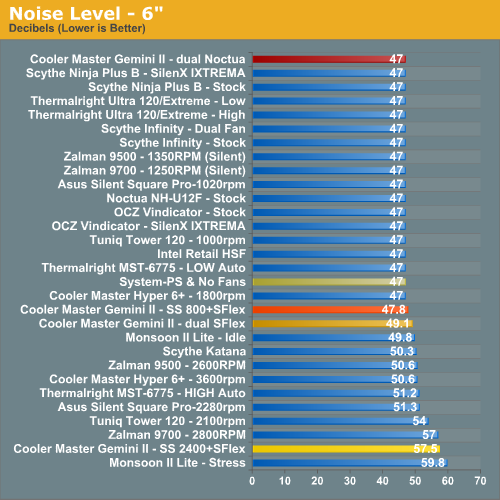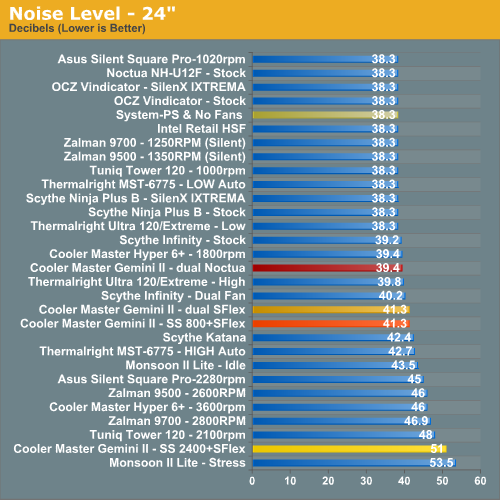Cooler Master GeminII: Performer or Poser?
by Wesley Fink on April 30, 2007 2:00 AM EST- Posted in
- Cases/Cooling/PSUs
Noise
For many enthusiasts upgrading cooling the goal is maximum stable overclock, and they will live with the inconvenience of a louder system. For other users silence is the most important factor, and these users will forgo maximum overclocking if that increases system noise levels.
There are virtually no power supplies that do not include a fan. While Zalman and a few others do make an expensive fanless power supplies, we have not seen a fanless unit larger than 500W, or one that would be used for seriously overclocking a system. With that in mind the noise level of the system with all fans turned off except the power supply was measured. The power supply used for the cooling test bed was the OCZ PowerStream 520, which is one of the quieter of the high performance power supplies.
We have also measured the Corsair 620-watt and Mushkin 650-watt power supplies which are reported to be quieter than the OCZ. Both the Corsair and Mushkin are indeed quieter at idle or start up speed. However, as soon as load testing begins and the PSU fan speed kicks up the measured noise level is almost exactly the same as the OCZ PowerStream 520 watt power supply.
We are currently in the process of evaluating "quieter" power supplies for an update to our cooler test bed. We will make changes to that test bed as soon as we are confident in the noise measurements and test procedures with a variable speed quiet PSU. We plan to evaluate additional power supplies and configurations in our upcoming 120mm fan roundup, at which point we will complete the transition to a revised and lower noise cooler test bed.
The noise level of the power supply was 38.3 dbA from 24" (61cm) and 47 dbA from 6" (152mm). The measured noise level of the test room is 36.4 dbA, which would be considered a relatively quiet room with a noise floor slightly below the OCZ PowerStream 520 PSU.
We measured noise levels with the GeminII in four fan configurations ranging from relative quiet to high-output and somewhat noisy. Results were then compared to the other coolers/fans tested in this category.


Measured noise levels in this chart should be considered worst case. Measurements were taken with an open side of a mid tower case 6" and 24" from the HSF. Real world would be a completely closed case resulting in a further reduction in noise.
The measured noise levels at 6" and 24" are below the system noise floor with dual Noctua fans to a less than quiet 50 dBA plus with the 110CFM+Scythe SFLEX configuration. The GeminII is very flexible in the fans that can be used with the cooler, but it did not deliver better cooling with higher output and much higher noise fans. Our advice would be to combine this cooler with medium output low noise fans. This should give the best balance of cooling and noise. However, if performance cooling is your goal with a new HSF you will likely be happier with the performance of a top Thermalright, Tuniq, Scythe, or Noctua cooler.
For many enthusiasts upgrading cooling the goal is maximum stable overclock, and they will live with the inconvenience of a louder system. For other users silence is the most important factor, and these users will forgo maximum overclocking if that increases system noise levels.
There are virtually no power supplies that do not include a fan. While Zalman and a few others do make an expensive fanless power supplies, we have not seen a fanless unit larger than 500W, or one that would be used for seriously overclocking a system. With that in mind the noise level of the system with all fans turned off except the power supply was measured. The power supply used for the cooling test bed was the OCZ PowerStream 520, which is one of the quieter of the high performance power supplies.
We have also measured the Corsair 620-watt and Mushkin 650-watt power supplies which are reported to be quieter than the OCZ. Both the Corsair and Mushkin are indeed quieter at idle or start up speed. However, as soon as load testing begins and the PSU fan speed kicks up the measured noise level is almost exactly the same as the OCZ PowerStream 520 watt power supply.
We are currently in the process of evaluating "quieter" power supplies for an update to our cooler test bed. We will make changes to that test bed as soon as we are confident in the noise measurements and test procedures with a variable speed quiet PSU. We plan to evaluate additional power supplies and configurations in our upcoming 120mm fan roundup, at which point we will complete the transition to a revised and lower noise cooler test bed.
The noise level of the power supply was 38.3 dbA from 24" (61cm) and 47 dbA from 6" (152mm). The measured noise level of the test room is 36.4 dbA, which would be considered a relatively quiet room with a noise floor slightly below the OCZ PowerStream 520 PSU.
We measured noise levels with the GeminII in four fan configurations ranging from relative quiet to high-output and somewhat noisy. Results were then compared to the other coolers/fans tested in this category.


Measured noise levels in this chart should be considered worst case. Measurements were taken with an open side of a mid tower case 6" and 24" from the HSF. Real world would be a completely closed case resulting in a further reduction in noise.
The measured noise levels at 6" and 24" are below the system noise floor with dual Noctua fans to a less than quiet 50 dBA plus with the 110CFM+Scythe SFLEX configuration. The GeminII is very flexible in the fans that can be used with the cooler, but it did not deliver better cooling with higher output and much higher noise fans. Our advice would be to combine this cooler with medium output low noise fans. This should give the best balance of cooling and noise. However, if performance cooling is your goal with a new HSF you will likely be happier with the performance of a top Thermalright, Tuniq, Scythe, or Noctua cooler.










44 Comments
View All Comments
acejj26 - Monday, April 30, 2007 - link
Page 4...MHz, not GHzAnnihilatorX - Monday, April 30, 2007 - link
I have a feeling that the size of CPU coolers is directionaly proportional to the trend of global warmingDon't take this too seriously
Though the CPU TDPs are relatively constant at ~110W for high end CPUs, the coolers have been more and more elaborate.
Wesley Fink - Monday, April 30, 2007 - link
While TDP (Thermal Design Power or Thermal Design Point)has not varied a great deal recently, the wattage demands of a CPU in overclocking are MUCH higher than at stock speed, and they increase as the overclocking goes up as it dramaticlly does with the current Core 2 Duo processors. The more elaborate cooler designs are to effectively cool in the highest possible overclocking configuration OR to more efficiently cool with less air volume (noise reduction).We evaluate coolers using both these criteria - overclocking and relative noise.
Were we to evaluate coolers on just how well they cooled at rated CPU speed - which we do include in our reviews as "Stock Speed Performance" - our results table would likely look different and our recommendations would also be different.
pannivas - Monday, April 30, 2007 - link
Maybe I haven’t searched hard enough, but until now this cooler is the only cooler that can fit my Zalman HD135 HTPC case 130mm(H) and perform good as well as silently.stromgald - Monday, April 30, 2007 - link
The Thermalright XP-120 is also a good option for low-profile cases. I saw a review where it performed better than the Thermalright MST-6775, which is in this review, so I think it should be in the ball park of the Gemini II. It's also probably cheaper since it's smaller, and quieter since it only uses one 120mm fan.yacoub - Monday, April 30, 2007 - link
So basically if you're someone who is looking for a cooler that's average amongst the top aftermarket coolers in prowess, offers a lower height that should fit in just about any case, can mount twin 120mm fans, is practically silent in operation with the right fans, and directs airflow down over the board removing the need for an additional fan to do the that, it could be seen as a good product worth using?Wesley Fink - Monday, April 30, 2007 - link
If you need a shorter cooler this could be a good choice. It can definitely be "silent" with the right fan(s). It does cool much better than the Intel retail fan.thechucklesstart - Monday, April 30, 2007 - link
If you set up the fans in a pull configuration if it would increase cooling?Most vehicles have a pulling fan on their radiator because it is more efficient than a pushing fan and this situation seems similar.
Wesley Fink - Monday, April 30, 2007 - link
All Cooler Master diagrams and specifications show the fans mounted to blow air down toward the motherboard and components. We tested the fans mounted as Cooler Master specified. The fan wounting direction could be reversed if that is what you choose.BladeVenom - Monday, April 30, 2007 - link
I think it's would be worth testing. He's not the only one wondering if it might be better that way.